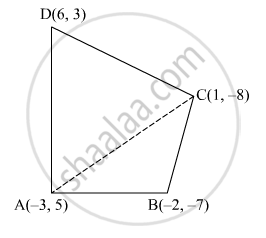Advertisements
Advertisements
प्रश्न
If A(−3, 5), B(−2, −7), C(1, −8) and D(6, 3) are the vertices of a quadrilateral ABCD, find its area.
उत्तर
It is given that A(−3, 5), B(−2, −7), C(1, −8) and D(6, 3) are the vertices of a quadrilateral ABCD.

Area of the quadrilateral ABCD = Area of ∆ABC + Area of ∆ACD
\[\text{ ar } \left( ∆ ABC \right) = \frac{1}{2}\left| x_1 \left( y_2 - y_3 \right) + x_2 \left( y_3 - y_1 \right) + x_3 \left( y_1 - y_2 \right) \right|\]
\[ = \frac{1}{2}\left| - 3\left[ - 7 - \left( - 8 \right) \right] + \left( - 2 \right)\left( - 8 - 5 \right) + 1\left[ 5 - \left( - 7 \right) \right] \right|\]
\[ = \frac{1}{2}\left| - 3 + 26 + 12 \right|\]
\[ = \frac{35}{2}\text{ square units } \]
\[\text{ ar } \left( ∆ ACD \right) = \frac{1}{2}\left| x_1 \left( y_2 - y_3 \right) + x_2 \left( y_3 - y_1 \right) + x_3 \left( y_1 - y_2 \right) \right|\]
\[ = \frac{1}{2}\left| - 3\left( - 8 - 3 \right) + 1\left( 3 - 5 \right) + 6\left[ 5 - \left( - 8 \right) \right] \right|\]
\[ = \frac{1}{2}\left| 33 - 2 + 78 \right|\]
\[ = \frac{109}{2} \text{ square units } \]
∴ Area of the quadrilateral ABCD =\[\frac{35}{2} + \frac{109}{2} = \frac{144}{2} = 72\] square units
Hence, the area of the given quadrilateral is 72 square units.
APPEARS IN
संबंधित प्रश्न
The three vertices of a parallelogram are (3, 4) (3, 8) and (9, 8). Find the fourth vertex.
Find the value of k, if the point P (0, 2) is equidistant from (3, k) and (k, 5).
If two opposite vertices of a square are (5, 4) and (1, −6), find the coordinates of its remaining two vertices.
Show that the points A(5, 6), B(1, 5), C(2, 1) and D(6,2) are the vertices of a square.
Find the equation of the perpendicular bisector of the line segment joining points (7, 1) and (3,5).
Find the ratio in which the line segment joining (-2, -3) and (5, 6) is divided by x-axis Also, find the coordinates of the point of division in each case.
The points A(2, 0), B(9, 1) C(11, 6) and D(4, 4) are the vertices of a quadrilateral ABCD. Determine whether ABCD is a rhombus or not.
Find the coordinates of the points which divide the line segment joining the points (-4, 0) and (0, 6) in four equal parts.
If the poin A(0,2) is equidistant form the points B (3, p) and C (p ,5) find the value of p. Also, find the length of AB.
Show that the points A(6,1), B(8,2), C(9,4) and D(7,3) are the vertices of a rhombus. Find its area.
Find the coordinates of the midpoints of the line segment joining
P(-11,-8) and Q(8,-2)
The line segment joining A( 2,9) and B(6,3) is a diameter of a circle with center C. Find the coordinates of C
Find the coordinates of the circumcentre of a triangle whose vertices are (–3, 1), (0, –2) and (1, 3).
What is the area of the triangle formed by the points O (0, 0), A (6, 0) and B (0, 4)?
Find the values of x for which the distance between the point P(2, −3), and Q (x, 5) is 10.
If P (2, 6) is the mid-point of the line segment joining A(6, 5) and B(4, y), find y.
If the area of the triangle formed by the points (x, 2x), (−2, 6) and (3, 1) is 5 square units , then x =
Any point on the line y = x is of the form ______.

In the above figure, seg PA, seg QB and RC are perpendicular to seg AC. From the information given in the figure, prove that: `1/x + 1/y = 1/z`
Find the point on the y-axis which is equidistant from the points (5, −2) and (−3, 2).
